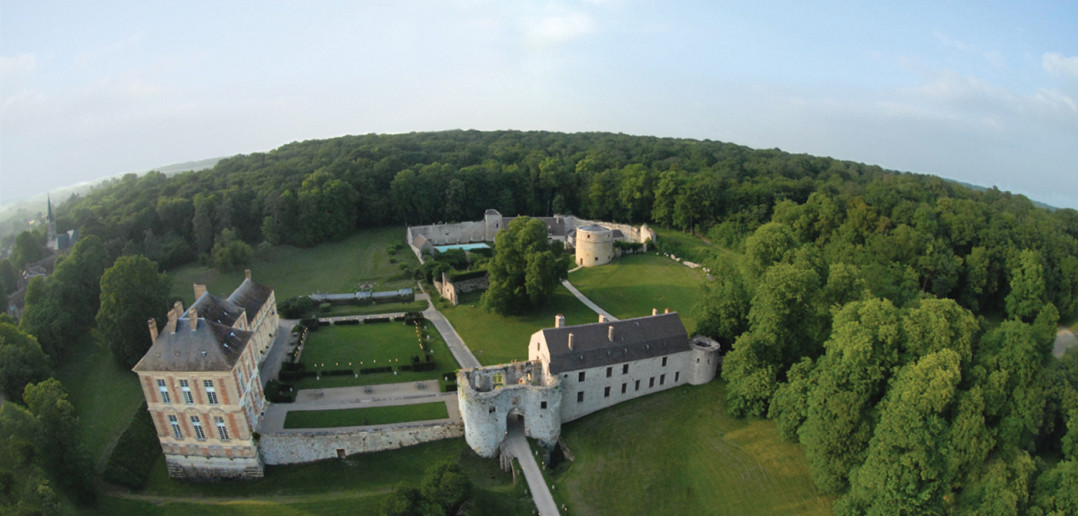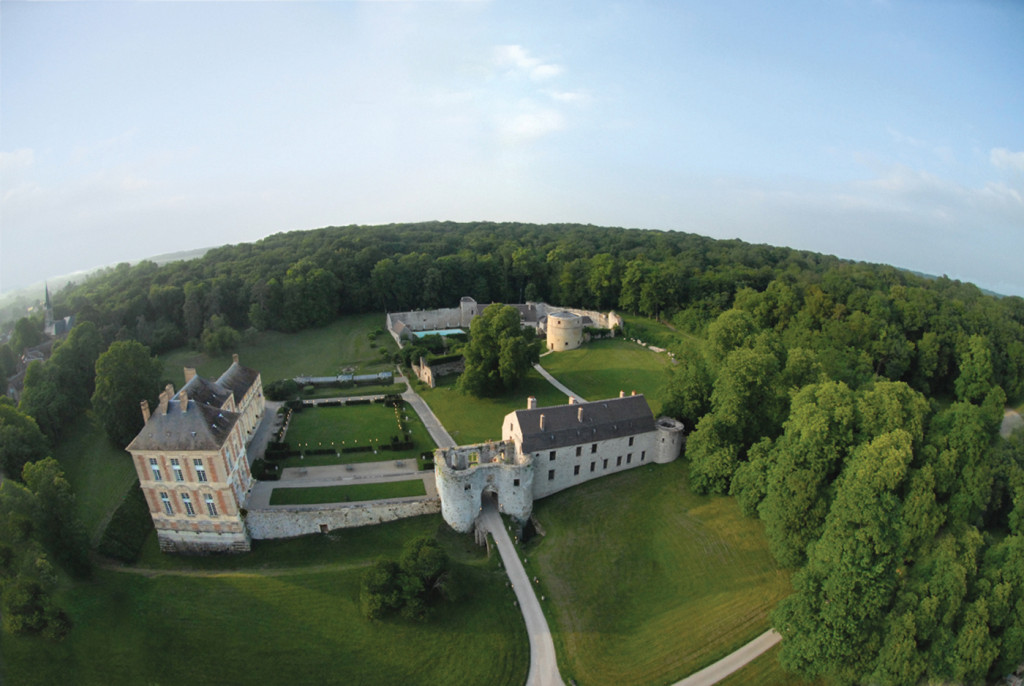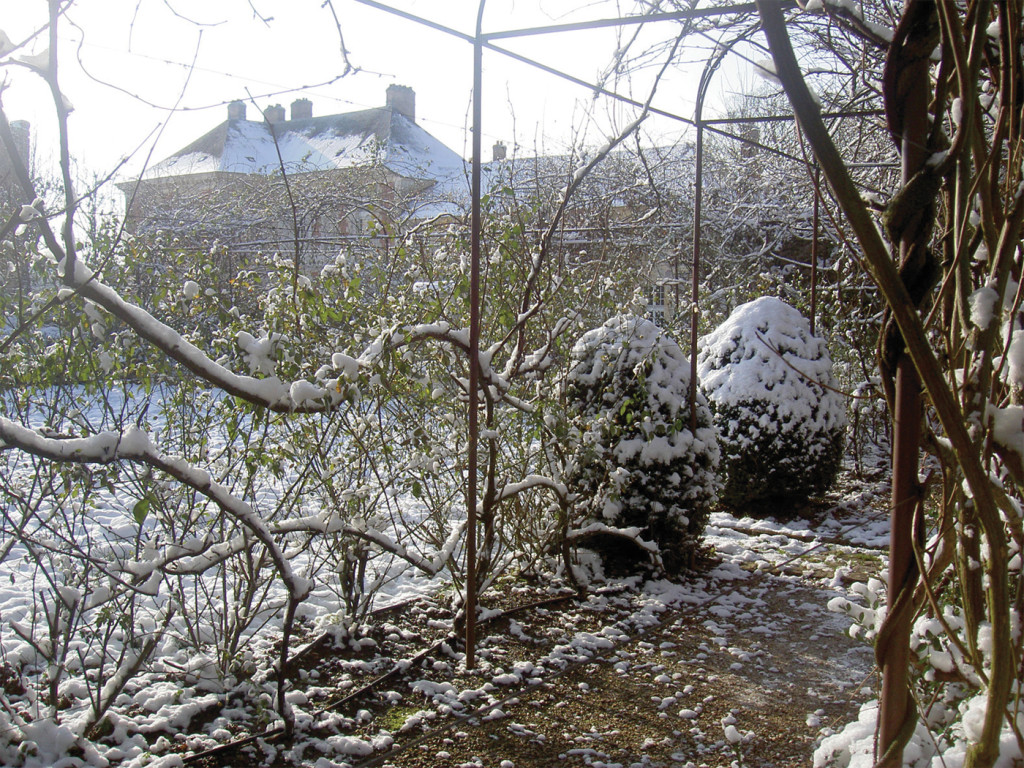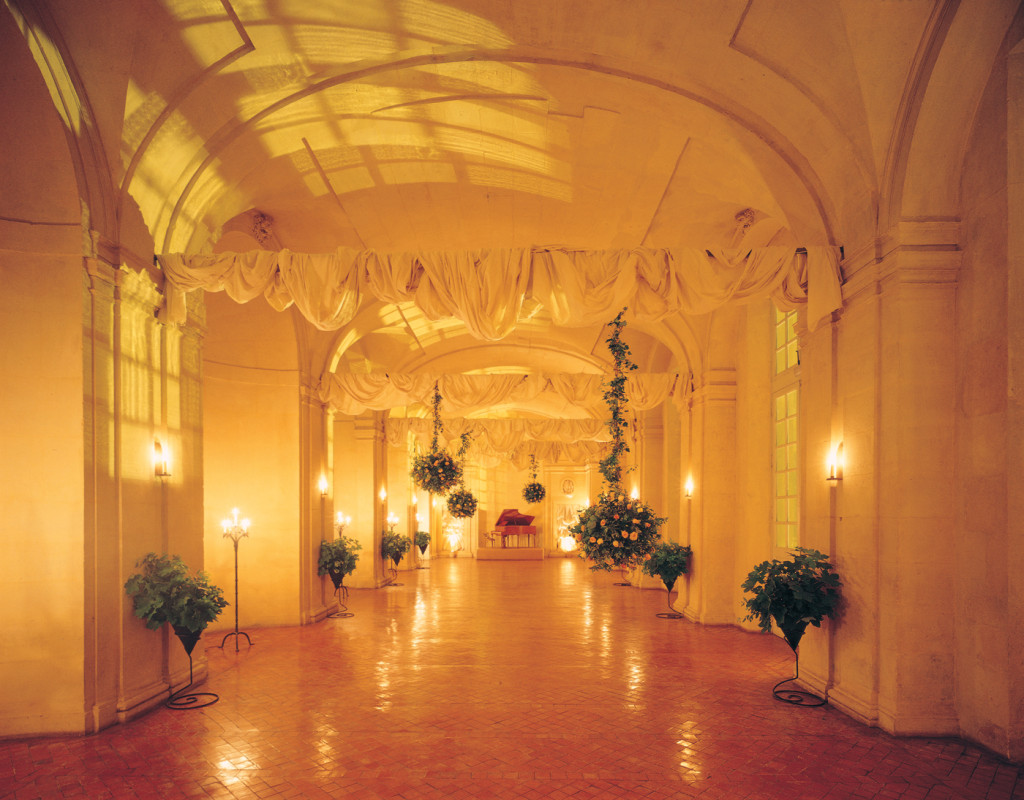Honeymoon in France | A Historic Chateau
Where to Stay:
Château de Vallery
www.chateaudevallery.com/EN/
Tel: 33(0)3 86 97 77 00
Do you dream of a destination wedding or a honeymoon in an exotic, far-off land, untouched by time itself?
Centuries ago, in 1528, Le Maréchal de Saint André, the favorite of King Henry II of France, created his own hideaway south of the ancient city of Paris. His magnificent retreat, Château des Condé, now Château de Vallery, soon played host to French royalty in its magnificent grounds, grand ballrooms, and intimate spaces.
Home to more than its share of renowned celebrations over the centuries, the château eventually fell into disrepair, becoming a faded relic of its old glory.
Enter the visionary Patrice Vansteenberghe. An architect, he had created the Virgin mega-store on the Champs-Élysées, which on many days is the greatest tourist attraction in France, outdrawing even the Eiffel Tower and the Louvre.
He visited the château and soon had a clear vision for reviving its splendor. In 1989 he purchased the property, and now his inspired transformation has restored the site to its former glory, while also updating it to accommodate today’s modern sensibilities.
The beauty, history, and culture of France, both ancient and modern, are all vividly present at Château des Condé, a listed historical monument. One hour to the south of Paris, the château is a mini-kingdom of halls and lounges, forests, a complete sound system on the grounds, and 24 rooms and suites.
We had the great pleasure of visiting the château for this issue, and discovered that, even more captivating than its architectural magic, is the generous spirit of hospitality and worldly grace that Patrice, his lovely wife Ariane, and their exceptional staff have cast over the grounds. Like an ancient charm, their spirit extends itself to all visitors.
“Along with the village,” says Patrice, “we can accommodate up to 130 guests, not to mention the bed and breakfast in the surrounding area. Sheltering behind our 12th century ramparts are the Oriental pavilion and its reflection pool. Close by,” adds Patrice poetically, “the dovecot, which was initially used to house pigeons and is today dedicated to the moon, is already dreaming of your wedding night.”
Historic Celebrations
“France is the country perhaps most visited by tourists,” says Patrice, “because of the high quality of its fine food and wine, its incomparable heritage, and the fact that the country remains the guarantor of centuries-old traditions.”
In past eras, royals would impress ambassadors from across Europe with festivities in the castles of Versailles, Fontainebleau, the Louvre, and Chambord. “In like manner, the princes of France would try to capture the attention of the king with their own parties.”
At the time of the Renaissance, the parties were created with the aid of many talented artists, some of whose professions have since disappeared. “Of course, around the castle of Vallery we keep the best cooks, pyrotechnicians for fireworks, and florists, but among the traditions that have disappeared are the sandblasters, who would decorate the tables with landscapes composed entirely of colored sand. Almost completely gone as well are the fountain makers and architects, who would construct elaborate sets to capture everyone’s attention.”
A Magical Wedding Weekend
“Come to the estate on the eve of your big day and settle into the château’s historic rooms with your guests,” says Patrice. “You could kick off the evening with a tasting of fine wines in our vaulted 12th-century cellars, sampling the wines of different French vineyards, especially Burgundy, as the castle is located in the village of Vallery in Burgundy. Afterwards, why not enjoy a tajine served at dusk in the pavilion with its big pool?
“On the morning of your wedding, make yourself at home,” says Patrice. “For some, the church, standing opposite the château on the edge of the forest, with its mausoleum dedicated to the princes and princesses of Condé, will be perfect for their ceremony. Others might choose a flower-laden chuppa erected in our rose garden. Or why not the park? Or the big Buddha at the foot of an oak tree several centuries old. Spirituality is the order of the day.”
For drinks and supper, buffet tables can be set up around the pool. “Music selected by the bride and groom will float over the grounds, perhaps interspersed with numbers by a jazz band performing in the dovecot. Later, enjoy a candle-lit dinner in the Salle des Tentures, our large hall, with its sumptuous trompe-l’oeil of precious fabrics. On the grounds, torches flicker until dawn.
“After supper, everyone steps out into the grounds or onto the front steps for a fireworks show set to music, or perhaps a bonfire. Next we welcome the wedding cake, paraded into the Grande Galerie, and then a champagne pyramid marks the opening of the ball. Music playing on the grounds sends flutters through the surrounding forest. The château is for you alone, exclusively.
“After the festivities, nights are spent in rooms and suites preserved from all modernity. On the following day, you can enjoy brunch around the pool, enveloped in fragrances rising up from the gardens, or stroll through the forest or beneath the ramparts. Aperitifs served in the vaulted cellars can be followed by salads, salmon, and grilled meats to round off a sequence of life’s small pleasures.
“We compose the event depending on the personality of the bride and the groom-to-be, and take pleasure creating with them their celebration.
“The wedding theme should be interpreted in the bristol invitation, in the décor of the spaces and the tables, the colors of their fireworks or a pyromélodie. It will also find itself on the wedding cake and the board of thanks that it is customary to send each guest a few weeks after the wedding.
“The castle keeps in its stones many themes of different weddings,” says Patrice, “and still remembers them today.”
A Guided Tour
“Events always begin with a friendly welcome to the sound of music, from the car park, with 150 spaces, to the torches whose dancing flames light up the grounds. The guests, at leisurely private evenings, are invited either to check into their rooms and then gather in the medieval cellars for a wine-tasting session featuring vintage nectars, or they might stroll around the ramparts and the village of Vallery with its picturesque church.
“Hedges and enclosed flowerbeds adorn the four corners of the garden, offering visual counterbalance to the Rose Garden opposite.”
Wine parties, firework displays, bonfire parties, and brunch are held on the grounds all year round.
The grand Salle des Tentures is situated on the first floor. Your wedding ceremony, or any other event, can be held in this hall or in the Grande Galerie. The facades are made from brick and stone that boast some very detailed rustic work.
The most illustrious artists worked at Vallery, some of whom had contributed to the king’s palace at Fontainebleau. The facades of the château were clad in red and black polychromatic marble, of which a few vestiges have survived on certain cartouches and on the triangular pediments that crown some of the windows.
“In 1621, an oak tree was planted 50 meters to the right of the bridle-path overlooking the castle,” says Patrice. “It marked the birth of the fourth Prince of Condé and is now almost 400 years old.”
The ramparts include various examples of centuries-old military defense. There are the bracket-like architectural details, plus “machicolations,” the openings from which arrows were aimed and shot, discouraging assailants from attacking the fortification.
A Cherished Past
In the 13th century, when minstrels strolled around the medieval citadel, pyrotechnicians engineered the festivities. The fortress could then accommodate 5,000 men in arms, and a vast enclosure wall flanked with towers from different ages remains from this epoch.
On April 16, 1548, this land in Vallery was acquired by King Henry II’s favorite, Le Maréchal de Saint André. The marshal dreamed of a palace where he could host truly grand festivities. He therefore called upon the most talented architect of that time, Pierre Lescot.
Canon of Notre Dame de Paris for 25 years, Lescot enjoyed the supreme honor of constructing the Louvre under the reign of five successive kings.
Saint André excelled at creating surprises for his guests during dinner, using concealed mechanisms to transform the décor. “After the first course, the table would split in two, one half gliding to the right and the other to the left. At that very moment, out of the ground rose a table bearing an exquisite display of all types of fruit, sugared almonds, and preserves. And once that table had disappeared like the first, a third table appeared.”
The marshal called upon the services of “Sableurs” to conjure up icy snowscapes on sideboards and tables. As the meal progressed, optical illusions created the impression that the trees inside the ice were growing leaves and that fields were flowering. The kitchen staff designed triumphal arches in nougat, and almond paste replicas were occasionally hung from the fruit trees in the orchard, in a delightful and delicious fraud!
Under Saint André — who equipped his château with a menagerie from which he offered a bear to the dauphin, the son of Henri II — Vallery was in a permanent whirlwind of hunts and banquets, masked balls, and wild feasts. It rang with the sounds of dancing, laughter, whispers, and the rustle of fine fabrics.
Over a century later, Louis II of Bourbon, the fourth Prince of Condé, was born and raised at the chateau in Vallery. Appointed commander of the army of Picardie, he became known as “Le Grand Condé.”
Throughout his life, the flamboyant hero was committed to protecting and encouraging artists such as Molière, Racine, Corneille, La Bruyère, and Boileau. “But after his passing,” says Patrice, “the château gradually began to sink into oblivion, as the descendants of the princes of Condé struggled to meet the enormous maintenance costs.”
Your Own Castle
“One summer at the end of the 1980’s I was camped out on the ground floor of the Renaissance building,” recalls Patrice. “It was the only section still vaguely habitable at that time. Guides were showing visitors around an ivy ruin, the noble remains of a prestigious past. Yet the number of people visiting the château confirmed my view that such an architectural ensemble had to be saved.”
In December of 1989 he acquired the château. “With the help of the Department for the Conservation of Monuments and Historic Buildings, I knocked down the intermediary walls that divided the Grande Galerie into nine salons and bedrooms, all dilapidated, on two floors. I then created a 500 square meter trompe-l’oeil inspired by the ‘Camp du Drap d’Or’ for the Salle des Tentures, which is reserved for candle-lit suppers. Next came the Medieval Cellars and 20 or so bedrooms. Later, we unearthed the stone bridge that leads to the entrance tower.
“Today, I am still an architect, but my main occupation is hiring out the Château de Vallery for weddings, timeless celebrations that glow through the night, illuminated by the dancing flames of torches that burn until dawn within the ramparts, and forever in our hearts.
“Here, every wedding is exceptional,” says Patrice. “Large or small, each one is unique, and those that are yet to be celebrated here will be different again — perhaps because each bride and groom have their own past, present, and future.
“A modest and simple wedding reception can be as thrilling as the most luxurious of events, because the place itself is generous. There are no restrictions here. All night long the sound of music drifts to the very fringes of the forest.
“A special wedding tradition has been established here,” says Patrice with pride, “the spectacular arrival of the wedding cake. Once night falls, the guests gather in the grounds or on the main steps. Slowly, the maitre d’s emerge out of the night, their silhouettes glowing in the torchlight as they hold the illuminated wedding cake aloft. It glides across the grounds like a ship’s figurehead.
“Parties at the Château de Vallery are often dynamic. One might have a fortune-telling booth in the basement of the entrance tower; another, a traditionally attired man on stilts welcoming guests to the snow-covered grounds; still another, a jazz concert in the Pavillon du Grand Bassin.”
Fireworks and Music
“The history and architecture of any specific entity will determine the form of expression most suited to it,” says Patrice. “One monument may inspire the pyrotechnician to bombard the skies with multicolored explosions. But our setting calls for subtler effects that add spirit to the site and address the soul without numbing the senses. A display may open with a row of flares casting a haunting purple glow over the fringes of the mysterious forest.
“Catherine-wheels and gold and silver suns spark up along the length of the bridle-paths. The entrance tower has already been transformed into an immense fountain with overflowing waters. Stone, music, and fire fuse, hovering over the grounds.
“A huge bonfire in honor of St. Joan de Arc can burn until dawn, offering warmth to anyone choosing to leave the party behind them for a moment, in the heart of the night, for a journey around the gardens, the ramparts, and the torchlit grounds.
“At night, beneath starry Renaissance skies, here to the south of Paris, time stands still to please you,” says Patrice poetically, “and harmony reigns.” Next he offers a centuries-old tribute to his restored castle, written by the poet Ronsard in 1555. “No finer setting can there be in which your love to pledge.”






